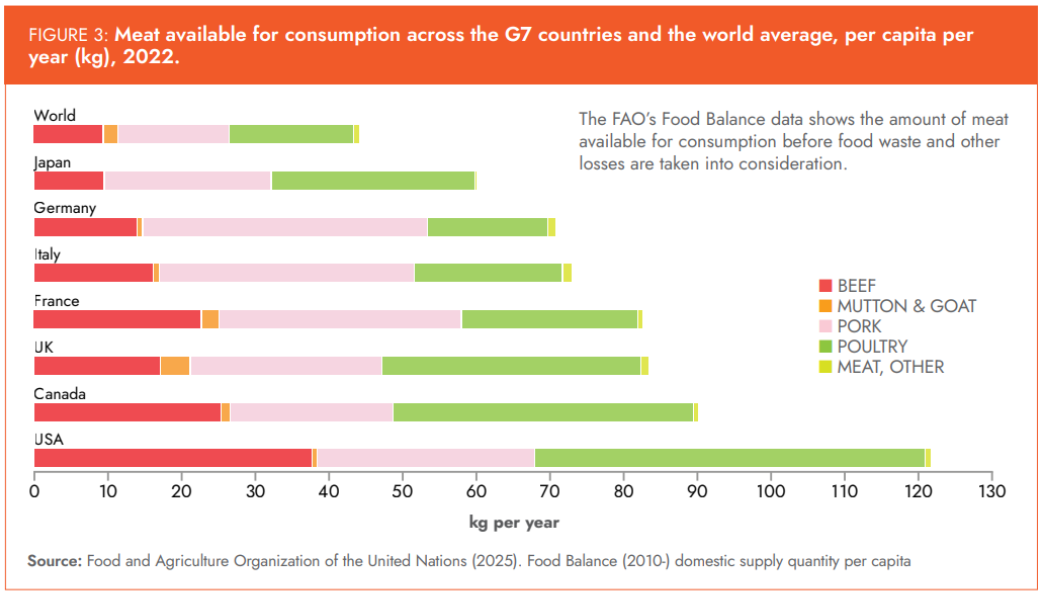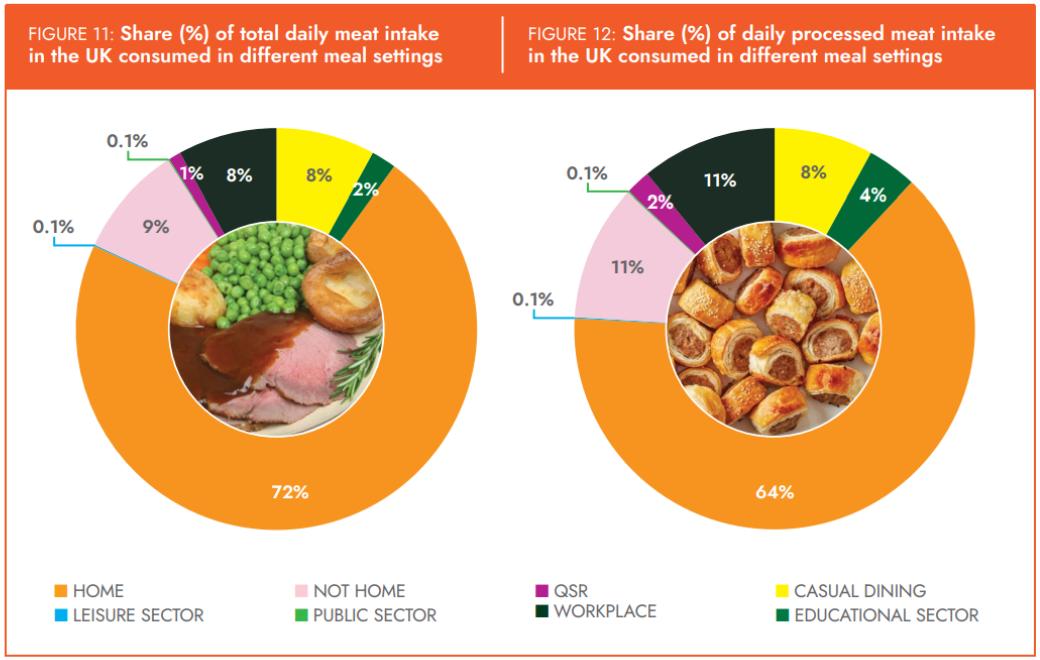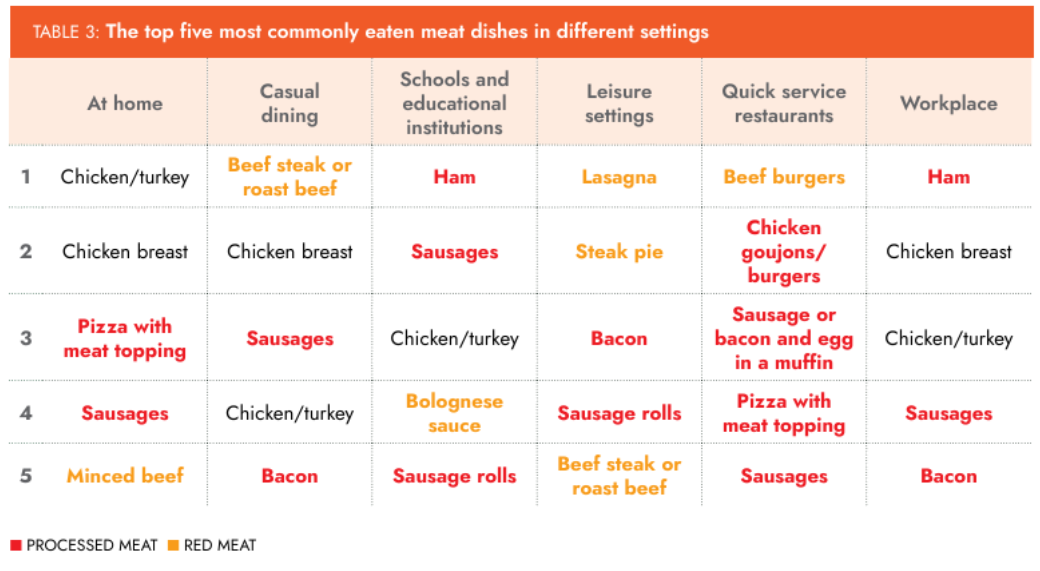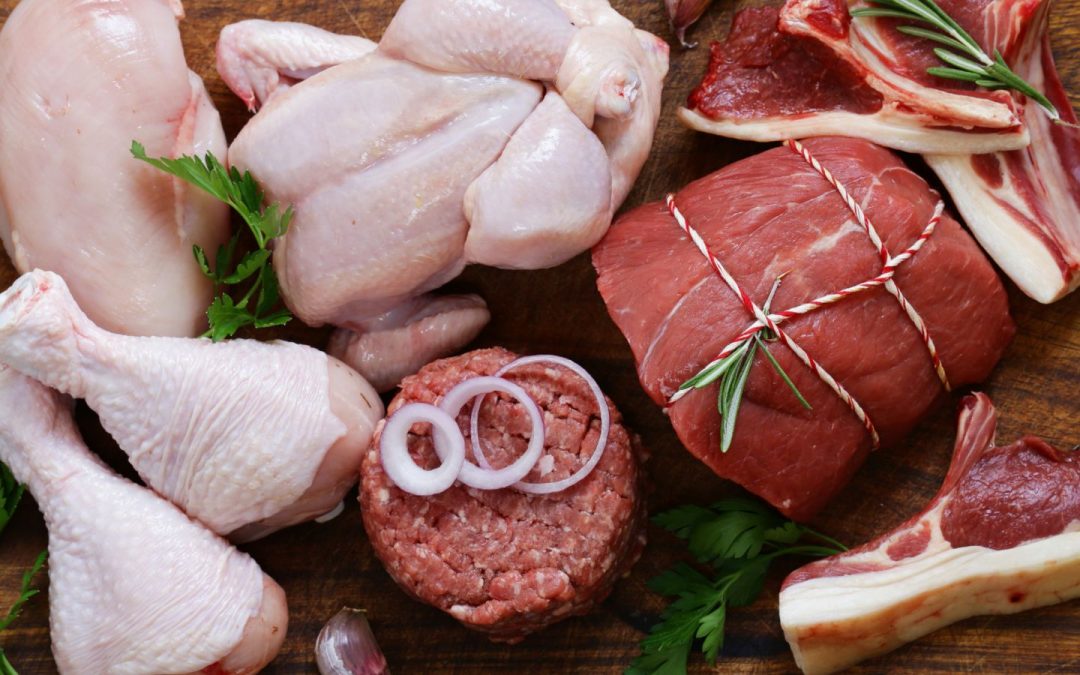
By Katina-Leigh Taylor, Project Assistant, The Food Foundation
Meat has long been a staple of diets in the UK, but a growing body of evidence suggests we need to rethink how much, what kind, and why we eat it. The Food Foundation’s recent Meat Facts report highlights key reasons why the way we consume meat isn’t sustainable – for our health or our environment.
Here are the key facts from the Meat Facts report, with some reflections from the MyNutriWeb dietitians on what they mean for us all:
The UK eats twice as much meat as the global average.
On average, the UK is eating 89g of meat each day which equates to roughly three slices of beef or a large quarter pounder beef burger. Adults eat 93g of meat each day with children (those under age 18) eating smaller amounts (72g). According to the Eatwell Guide, 12% of our diets should be comprised of protein sources. The Protein segment of the Eatwell Guide was significantly been revamped in 2016 to more embrace sustainability and the need for increased plant-based protein consumption. The old section in the previous Eatwell Plate ie “Meat, fish, eggs, beans and other non-dairy sources of protein” became ‘Beans, pulses, fish, eggs, meat and other proteins’ with the sub-line ‘Eat more beans and pulses, 2 portions of sustainably sourced fish per week, one of which is oily. Eat less red and processed meat.’ It also recommends that if anyone is eating more than 90g of red or processed meat a day they reduce this to no more than 70g/day.

Over a third (36%) of the meat children eat is processed despite the associated health risks.
This is particularly concerning given the evidence linking the overconsumption of processed meat to greater risk of developing chronic diseases in adulthood. Processed meat is linked to diet-related diseases including cancer and cardiovascular disease. Based on the available evidence from epidemiological (population) studies, the International Agency for Research on Cancer (IARC) classified processed meat as a Group 1 carcinogen (meaning it can cause cancer in humans), with the strongest link to colorectal (bowel) and stomach cancers. Although the precise mechanisms are not fully understood, it is thought that processes used to preserve meat and cooking at high temperatures can form a variety of cancer causing compounds in the final product.
Additionally, processed meat often contains a lot of salt and is high in saturated fat. Associated health risks of processed meat include increased risk of high blood pressure, stroke, cardiovascular disease and all-cause mortality. Strongest evidence is related to risk of bowel cancer. Studies have shown a dose-response relationship between level of intake and relative risk of disease. Analysis of 400 studies by WHO IARC show the relative risk of developing bowel cancer increases by about 18% with each additional 50g eaten per day (equivalent to one hot dog or two slices of ham). Recent studies have shown an increased risk of bowel cancer associated with eating even small amounts (under 50g per day). Cancer Research UK estimates that of the 42,000 new cases of bowel cancer that occur every year in the UK, 13% (or over 5,400) are caused by eating too much processed meat. This is an entirely avoidable risk.
There is currently insufficient evidence to establish a safe level of processed meat consumption. The World Cancer Research Fund International recommends eating ‘ ‘very little, if any’ processed meat. The most popular processed meats consumed amongst children in comparison to adults include sausages; coated chicken products like nuggets; and ham.
Northern Ireland eats the largest amount of meat of all UK nations.
Across the devolved nations, citizens in Northern Ireland eat significantly more meat than in England, Wales and Scotland, consuming an average of 180g of meat a day overall, as well as the largest amount of processed meat of all four nations, with Northern Ireland citizens eating 56% more processed meat than citizens in England.
Young men aged 19-40 eat the largest amount of processed meat of all demographic groups.
Men eat significantly more meat than women do, even when intake is adjusted for the lower amount of calories women consume on average. The largest difference in processed meat intake is seen with men eating 20% more processed meat on average than women do. Almost a third (31%) of all meat eaten by men is processed. Globally, men eat more meat than women, with a link between meat consumption and idealised notions of masculinity.
42% of the meat we eat is chicken, despite concerns around the way we farm and feed chickens.
The largest contributor to daily meat consumption is white meat, with most of it coming from chicken. While white meat has a better health profile than red and processed meat – with lower levels of saturated fat and sodium – and has a lower carbon footprint relative to red meat, there are other major trade-offs to be considered when it comes to chicken production. These include concerns around animal welfare, the use of antibiotics in the industrial livestock sector, the impact of intensive poultry farming on local pollution, and the impact of land clearing to grow animal feed on global deforestation and nature loss.
Almost a third (31%) of all meat eaten by men is processed, with men eating a fifth more processed meat than women.
Men eat significantly more red and processed meat than women do in the UK. This suggests that any campaigns or interventions to reach those eating the largest amounts of processed meat ought to be targeted towards young and middle-aged men.
9% of the meat children aged under 18 eat comes from pizza.
Pizza with meat toppings contributes a surprising amount of meat to UK diets when a wider range of dishes are considered. Pizza with meat toppings is the third most eaten type of dish containing any amount of meat eaten by children, and the fifth most frequently eaten among adults. However, chicken burgers and goujons are also most popular with children, and the most consumed type of meat or meat-containing dish eaten by this age-group overall.

Over a third (36%) of all the processed meat we eat in the UK is eaten ‘out of the home’ with 4 of the 5 most commonly eaten meat-containing dishes from fast food restaurants processed and/or ultra-processed meat.
The Out of Home sector contributes a notable amount of the processed meat eaten in the UK. Research from the University of Cambridge supports this, showing that 58% of main meal options available from the UK’s largest restaurant and fast-food chains are meaty, with meat-free options often very hard to come by (The Food Foundation, 2024). All five of the most eaten meat-containing dishes eaten in fast food outlets (Quick Service restaurants) and leisure settings (like tourist attractions or the cinema) are classified as red or processed meat. This includes chicken goujons/burgers; sausage and bacon muffins; pizza with meat toppings; and sausages. School Food Standards
Despite the health risks of processed meat consumption and School Food Standards suggesting that processed meat be served no more than 1x a week in primary schools, 4 out of 5 of the most commonly eaten meat dishes in schools and educational institutions are either processed (ham, sausages, sausage rolls) or red meat (bolognese sauce). This suggests we need better monitoring of school food standards as well as a review of the Government Buying Standards for Food. The current requirement for schools to serve meat three days a week should be relaxed, and guidance should recommend removing/limiting the amount of processed meat being served to children.

A third (32%) of the red meat we import is processed.
The UK is a net importer of beef, veal, pork and chicken. Of all three red meat categories analysed, pork is the type of red meat available in the largest quantity for consumption in the UK. This is notable given that many processed meat products are pork based, including bacon, sausages and ham. In addition to the health risks, this means that British livestock farmers are at risk of being undercut by cheap imports of meat produced to lower standards than those maintained in the UK.
From these facts we can see that there is an urgent need for policymakers and businesses to act to shift diets towards healthier and more sustainable patters, as well as opportunities for targeted public health campaigns, particularly aimed at younger men and families, to encourage healthier and more sustainable consumption.
The Meat Facts report also features a set of recommendations to encourage a shift towards less and better meat and towards more plant-rich diets:
Businesses are encouraged to reduce their reliance on processed meat, particularly in the Out of Home sector. Retailers should work towards excluding processed meat products from volume, location and price promotions in store and online, and food service businesses should reduce the number of processed meat-containing options and instead substitute this for beans and other plant proteins.
Businesses should also work towards making beans and whole plant foods more appealing. This means redirecting promotional spend towards nutritious plant foods in order to make them more appealing. Advertising and promotional strategies should be focused specifically on beans as the most affordable, sustainable and healthiest plant-based alternatives to meat, where intake is not patterned by level of income.
Policymakers are encouraged to support the production and increased consumption of fruit, vegetables and beans, pulses and legumes. Specifically, there should be a strategy across all the devolved nations for an expanded, thriving edible horticulture sector.
We also want investors, in their advocacy on well-designed reporting regulation, to advocate for mandatory corporate reporting across a range of health and sustainability metrics (including sales of protein by source). Dietitians and registered nutritionists and other health professionals are well positioned to advise the public on how to eat a more plant rich diet as well as advocating for processed meats to be taken off school menus in addition to menus in public and private institutions shifting away from a reliance on processed meat and towards more plant-rich options.







Regarding the statement ‘The UK eats twice as much meat as the global average’ . The Food Foundation report references UK meat consumption as 83kg per person annually, based on FAO Food Balance Sheets. However, this figure reflects availability, not actual intake. In contrast, NDNS data based on individual food diaries as highlighted in the report, shows average consumption is 89g/day, or approximately 32.5kg/year. This unintended discrepancy arises because FAO data includes carcass weight and does not account for inedible parts or consumer-level waste, leading to significantly higher estimates. To avoid confusion, a more accurate phrasing might be: “UK meat availability per person is estimated at 83kg annually, nearly double the global average of 44kg, but this reflects supply, not actual consumption.” Clarifying the distinction between these two data sources would improve transparency and help ensure the report’s conclusions are grounded in the most relevant and accurate data for the UK context
Hi Kate. Thanks for clarifying this. You are correct that the FAO dataset reflects availability and is only a proxy for consumption, and we make this very clear in the graph title and legend depicting this dataset (see figure 3 in Meat Facts).
I believe the issue is how we have summarised this finding for the wider public in our ‘top ten meat facts’. Going forward we will absolutely ensure that we rephrase the FAO findings so that this stat reads “The UK eats and wastes twice as much meat the global average”, which I’m sure you will agree remains of concern from both a nutrition and environmental perspective.